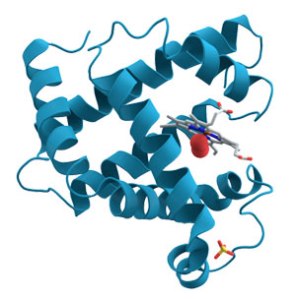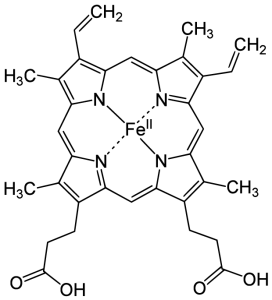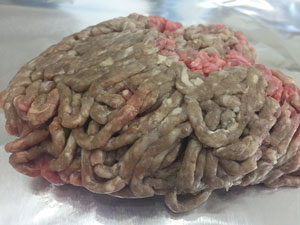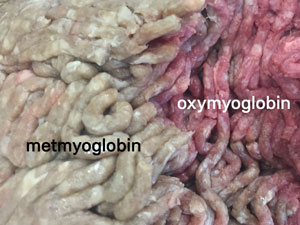Why Does Raw Ground Beef Turn Brown
I bought a lot of ground beef on sale, then I forgot about it! I had planned to separate it into smaller portions, wrap it up, and put in the freezer. But after a long shopping trip with kids, I just stuck it in the refrigerator. I forgot about it for days. When I finally pull it out, my bargain beef was brown! Did my super deal turn into a big waste of money or was the color change completely harmless?
Meat Color
Beef is red mostly because it contains myoglobin. Myoglobin has a protein portion attached to a nonprotein ring with iron at its center. It is in the muscle and "holds onto" oxygen. The best way to describe myoglobin is to compare it to a similar protein that more people have heard of: hemoglobin.
Hemoglobin is a protein in the blood. When hemoglobin has oxygen the protein folds in a way that makes it look red. That is why the blood coming away from your lungs is red. Some of that oxygen is passed to myoglobin in the muscles. Without oxygen, hemoglobin changes shape and takes on a slight blue hue. You can see the blue veins in your arm.

Back to myoglobin. Myoglobin holds oxygen in muscles until the muscle needs to move. Muscles use oxygen to contract. There is a big protein part called the globin. In the picture above, that is the squiggly blue part. There is also a nonprotein part called a heme group which is a ring with iron in the middle. In the picture above, it is the grey part next to the two red spheres. Below are two representations of just the heme group.


Colors of Myoglobin
Myoglobin changes shape based on what it is holding. The iron can bind with oxygen, water, nitric oxide, and more. I'm going to focus on just oxygen and water because those can cause color changes after meat is purchased from the store. Bacteria can also cause color changes. When that happens the smell or texture of the meat changes too.

Myoglobin that is not holding oxygen is a purple-red color. Freshly slaughtered meat or meat sealed in plastic that is not permeable to oxygen are this color. The bright red beef seen in stores has myoglobin that is holding oxygen, called oxymyoglobin. Metmyoglobin is myoglobin that has a water molecule attached. It is brown-red. It does not look great, but meat that has metmyoglobin is still safe to eat.
My Meat

I bought ground beef and let it sit in the refrigerator for about five days. When I took it out, my ground beef was brown on the outside but the inside was mostly red. It did not smell terrible. I knew it was not horribly rancid but it smelled a bit funky. I was not sure if the funky smell was just the smell of raw meat or something worse so I cooked it. The funky smell did not go away. I ended up throwing all the ground beef away. Better safe than sorry, right? After researching for this post, I'm guessing my meat was just starting to spoil.

The Food Safety and Inspection Service (FSIS) has a whole webpage about the colors of meat and poultry. They say that:
Change in color alone does not mean the product is spoiled. With spoilage there can be a change in color—often a fading or darkening. In addition to the color change, the meat or poultry will have an off odor, be sticky or tacky to the touch, or it may be slimy. If meat has developed these characteristics, it should not be used.
Take Home Lesson
Just because meat changes color does not mean it has gone bad. Purple-red beef and brown-red beef are completely fine to cook and eat if everything else about the meat seems normal. If meat smells funny, feels sticky or slimy, throw it away because the meat is spoiled.
Images: Aza Toth, Yikrazuul
Sources:
- "The Color of Meat and Poultry" by the Food Safety and Inspection Service.
- Essentials of Food Science, 4th Ed, by Vickie A. Vaclavik and Elizabeth W. Christian.
- "Meat Colour" by Jane Ann Boles and Ronald Pegg of the Montana State University and Saskatchewan Food Product Innovation Program.
- Modern Food Microbiology, 7th Ed, by James M. Jay, Martin J. Loessner, and David A. Golden
streicherhurew1943.blogspot.com
Source: https://adashofscience.com/2017/10/10/why-does-meat-turn-brown/
0 Response to "Why Does Raw Ground Beef Turn Brown"
Post a Comment